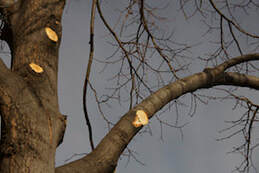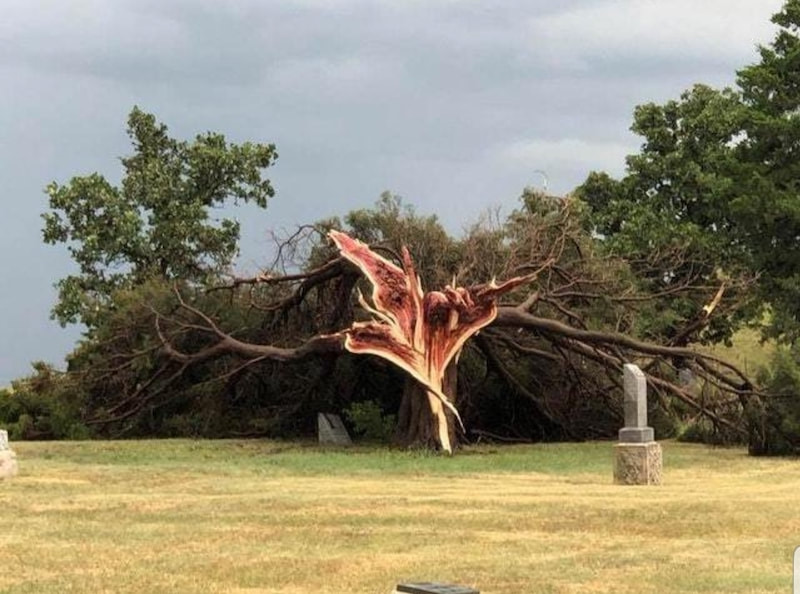|
A tree naturally becomes a lightning rod in times of storms, as it towers over houses and some buildings. There are approximately 100 lightning strikes per second worldwide, which means trees get hit by lightning more than you can imagine. While not all trees are vulnerable to lightning strikes, some can get severely affected.
When a tree gets struck by lightning, it can experience damage ranging from physical to internal ones. Obvious signs of damage include blowing off the bark, broken limbs, and splits in the wood. You may also notice charred areas on its trunk caused by burning from the heat of the lightning. The heat produced by the strike can cause the sap to turn into steam, creating bumps in the tree's bark that will kill its vascular system in time. If this is the case, the tree may look normal at first, but leaves will begin to fall off after a few days. Here is what you should do when your tree gets struck by lightning: It's important to know that most trees overcome lightning strikes. If your valued tree was hit by lightning, it is vital to know that it doesn't automatically mean death for your tree. Century-old trees have been struck by lightning more than we can guess but have managed to survive its effect. If your tree has been struck by lightning, don't panic. Stay calm and assess the situation with a sound mind. Ensure the safety of the area surrounding the tree. Do not get too close to the tree after a storm. Watch out for falling branches, downed electrical lines, and other tree-related debris. Ensure your family's safety, as well as your pets, and stay away from the site until the utility company has dealt with the affected power line and a tree service has assessed the tree. Contact a certified arborist to examine the tree's condition. Get in touch with a professional arborist in your area to conduct a thorough assessment of the lightning-struck tree. It is crucial to ask professional assistance to evaluate the condition of your tree to make sure you can give the correct treatment for your tree. The arborist may need to trim broken branches, brace and cable the weakened branches, or provide additional nutritional reinforcement. Remove all broken and damaged branches. Make sure to remove all broken and weakened branches from the affected tree. The certified arborist should eliminate any damaged branches and prune the tree to ensure it doesn't come into contact with your property or any power lines. It is best to ask your utility company to disconnect the power in the meantime to allow the tree service company to trim the trim back safely. Prepare your trees for future storms. Prevention is always better than cure. The same goes for the trees in your backyard. To reduce the risk of storm-related damage, have them regularly checked by a certified arborist. By identifying problem branches and providing proper treatment, you can prevent the worst-case scenario from happening. No matter how small or significant the damage caused by lightning is, it is crucial to have it assessed and treated to save it from death. Contact your Des Moines Tree Service, 2108 73rd St, Des Moines, IA 50324, 515-207-4419 and schedule an inspection to help your tree get back on track.  Trees no matter how beautiful and beneficial they are can still cause debates among homeowners. Some homeowners want the natural shade they offer and the magnificent color they bring as the season changes. But for some, fallen leaves, canopies blocking views, and maintenance, are just too much to handle. We will help you handle different situations by looking into laws related to trees in HOAs. What Happens When a Tree Becomes a Nuisance If your tree's branches or roots begin to grow over your neighbor's property, this is your tree becomes a nuisance. Your neighbor has the legal rights to handle the problem by trimming the overhanging branches or destroying invasive roots. This is the part where most homeowners commit mistakes. You have to make sure you talk to the tree owner or the landowner before doing anything to the tree. Your neighbor has no right to cut the roots off your tree. He is only allowed to cut branches that extend over his land. If you make a mistake, you could be responsible for any damage incurred. Common Tree Problems in HOAs Removing a tree that a homeowner wants to keep is different than trees in common area. HOAs should maintain a common area which includes general preservation and maintenance of landscaping. It is the board members' responsibility to make judgments that serve the interest of all parties involved. Some factors to consider are:
A tree may become a liability. Sadly, tree removal may be the only solution for specific issues. If the tree is a threat to safety and property damage, it should be removed right away. Other reasons may include:
Stress-Free Tree Removal When looking for a tree removal company, look for one that knows the restrictions your HOA has set. Here are some of the following reasons why a tree needs to be removed:
If you are not sure about the laws and restrictions your HOA has set, make sure to get in touch with them to ensure you are compliant with their rules. Des Moines Tree Service can support your claim or justification to remove a tree. Call us for a free consultation and estimate.  With winter upon us, this is an excellent time to trim and prune trees. During the winter months, the ground is hard reducing the impact heavy foot and equipment traffic can make on your lawn and landscape. Further, in the winter trees are dormant with very reduced sap flow, therefore trimming and pruning wounds don't yield much bleeding. Lastly, with the leaves gone, professional tree trimmers can view the entire tree structure making cutting a lot easier and more efficient. This also perhaps trained arborist to better inspect the tree for health, disease, and other structural problems. Tree trimming involves the reduction of overgrown and undesirable limbs. Trees that need to be regularly trimmed are mature species that must be kept in check with their surrounding environment. Landscape trees can grow in every direction whereas forest trees generally only grow upwards as they compete for sunlight. Therefore, mature trees on your property need to regularly trimmed to prevent overgrown and dangerous situations, such as limbs touching roofs and electrical lines. Tree trimming is tree care task every property owner should invest in to keep their trees healthy and trouble-free. Young trees can easily be pruned (see below) by the average homeowner, but large, mature trees must be trimmed by professionals with the right equipment and skill. This is because trimming large trees requires the cutter to reach the upper parts of the canopy, which requires climbing skill or a bucket truck. Also, lower heavy limbs to the ground (and then efficiently disposing of them) take experience and expertise. Tree pruning is a tree care task generally performed on young, immature trees as they are going. Pruning focuses growth on desirable limbs, removes dead and undesirable growth, and generally promotes overall healthy growth in young trees. While tree pruning can be done at any time of the year, late autumn and early winter are best. The average property owner can prune any young tree in their landscape with some basic knowledge of pruning tools and cuts. One word of advice is to cut less than you think in any given pruning sessions. It is always best to trim a little less than you may think as you can always re-prune again in several months. Tree trimming and pruning are necessary tree care maintenance jobs every property owner should perform or have a professional do. The time and money invested will yield countless years of enjoyment in your landscape. Call Des Moines Tree Service for a free tree trimming quote on large, mature trees. We usually can provide same day estimates, and get your work scheduled within a week or less. Planting a new tree in your landscape can be exciting. You get to select the type you like and then see it grow. A tree is a long-term investment in your landscape. This is why you want to be knowledgeable about selecting a healthy specimen.
Inspect the Roots: Depending on the tree size you buy, the roots may be different. Bare root trees should have roots approximately equal in length to the trunk. A larger tree sapling may have their roots burlapped and balled. This ball should be firm and unbroken. Other tree saplings may be sold in a pot. Be careful with potted trees as this could lead to the roots tangled in the container. Asses the Tree's Trunk: While you want the tree's roots to be healthy, you also want the trunk to be healthy too. There should be no sign of damage to the trunk, such as nicks, bruises or other blemishes. And the trunk should have a proper taper to it proving it is growing in an acceptable manner. Lastly, the bark on the trunk should be bright and healthy. Consider the Branches: All the branches should be smaller than the trunk, otherwise the tree will develop balance problems as it grows. In a newly planted tree, lower branches can help the tree develop and grow better. Further, branches position to the trunk should be wider vs narrower. This will aid the tree in providing additional support and balancing weight. Branches should also be spaced relatively consistently around the trunk. Once you select a tree, you may want to consider employing a tree service in West Des Moines area to properly plant it. Our tree planting services will guarantee you new tree sapling gets off to an excellent start. We can also advise you on the best locations to plant your new trees given the species you selected. Is there a tree within your landscape which may be perishing? In case there is, you might be in need of a tree elimination company in Des Moines, IA. Exactly how can you determine if a tree is without a doubt dying, as well as if it is, is actually elimination your sole choice? The following are a couple indicators which might possibly signify your tree is actually arriving at the conclusion of its lifespan.
1. A Smaller Amount of Leaves Trees create leaves to aid make food. A tree frequently drops its leaves in the winter season, so it does not need to make as much food whenever the climate is chilly and also dry. If your tree does not develop leaves soon after it's pleasant, it can be a symptom it is expiring. 2. Fragile Bark In the event that the bark on the tree ends up being breakable as well as begins falling away, this could be a signal that the tree is undoubtedly perishing. The bark is actually intended to safeguard the living component of the tree from vermins, wild animals as well as weather conditions. Whenever it is breakable as well as missing in large pieces, the tree ends up being a lot more unprotected. 3. Squishy Trunk From time to time the outside symptoms of decomposition won't be that apparent. Your Des Moines tree specialist may possibly need to assess the trunk of the tree. In case the trunk is soft, it is going to gradually end up being not capable to be a foundation for the framework of the tree. This causes the tree hazardous and also is actually a symptom of its death. 4. Dropping Branches Additionally, if the tree limbs of your tree begin to drop, it may be an indication the tree is not healthy and balanced. As the tree perishes, it can no longer maintain the limb structure. Your Alternatives Tree removal is definitely not the only solution you have when it comes to a perishing tree. You might attempt to treat the tree too. Depending upon the illness as well as the disorder of the tree, you might have to tap the services of a tree expert. Whether or not you have concerns regarding the health and wellness of your trees or maybe require a tree service in Des Moines, Iowa, make sure to contact a professional. |
AuthorOwner of Des Moines Tree Service Archives
January 2024
Categories
All
|


 RSS Feed
RSS Feed